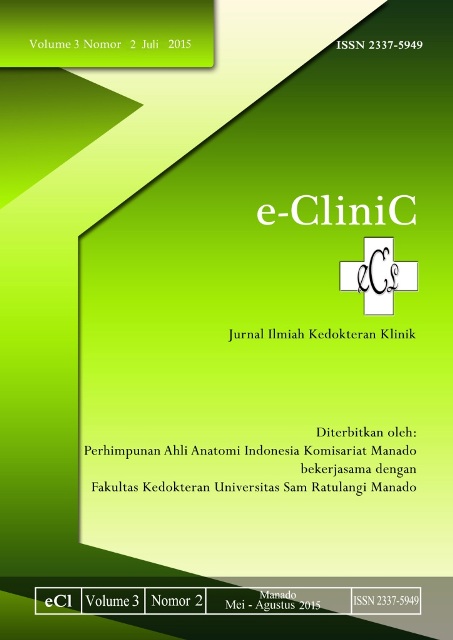PERBANDINGAN INSIDEN MUAL-MUNTAH PASCA PEMBERIAN ISOFLURAN DAN SEVOFLURAN PADA PASIEN BEDAH ORTOPEDI
DOI:
https://doi.org/10.35790/ecl.v3i2.8200Abstract
Abstract: Nausea and vomiting are common side effects after surgery and anesthesia. Nausea and vomiting can lead to dehydration, electrolyte disturbances, longer staying in the hospital, strained sutures of surgical wound, as well as the increasing of the occurence of dehiscence, hypertension, bleeding under the skin flap, risk of pulmonary aspiration due to decreased airway reflexes, and gastric mucosal ulceration. This study aimed to compare the incidence of nausea and vomiting after administration of isoflurane and sevoflurane in orthopedic surgery patients. This was an observational analytic study. Samples were all patients who underwent orthopedic surgery using inhaled isoflurane or sevoflurane form November to December 2012 conducted in Prof. Dr. R. D. Kandou Hospital Manado. Samples were obtained by using simple random sampling. The results showed that of 10 samples, there were 3 people who had nausea-vomiting (PONV); 2 people were administered inhaled isoflurane and the other one sevoflurane. The P values in both groups of samples> 0.05. Conclusion: The incidence of nausea and vomiting between inhaled isoflurane and sevoflurane in orthopedic surgery were not significantly different. However, the sevoflurane group had a lower incidence than isoflurane.
Keywords: PONV, isoflurane, sevoflurane, nausea, vomiting.
Abstrak: Mual-muntah ialah efek samping yang sering ditemukan setelah tindakan operasi dan anestesi. Mual-muntah dapat menyebabkan dehidrasi, gangguan elektrolit, waktu tinggal di rumah sakit lebih lama, jahitan luka operasi menjadi tegang, dan kemungkinan terjadi dehisensi, hipertensi, peningkatan perdarahan di bawah flap kulit, peningkatan resiko terjadinya aspirasi paru karena menurunnya refleks jalan nafas, dan ulserasi mukosa lambung. Penelitian ini bertujuan untuk membandingkan insiden mual-muntah pasca pemberian isofluran dan sevofluran pada pasien bedah ortopedi. Metode penelitian ialah observasional analitik. Sampel penelitian ialah seluruh pasien yang melakukan operasi ortopedi dengan menggunakan inhalasi isofluran dan sevofluran dalam periode November-Desember 2012 yang dilakukan di RSUP Prof. Dr. R. D. Kandou Manado. Pengambilan sampel menggunakan metode simple random sampling.Hasil penelitian memperlihatkan dari sampel sebanyak 10 orang, jumlah yang mengalami mual-muntah (PONV) sebanyak 3 orang. Jumlah sampel yang mengalami mual-muntah pada inhalasi isofluran sebanyak 2 orang dan sevofluran sebanyak 1 orang. Nilai P pada kedua kelompok sampel >0,05. Simpulan: Perbandingan insiden mual-muntah antara kelompok pengguna isofluran dan sevofluran pada bedah ortopedi tidak berbeda bermakna, namun, kelompok sevofluran memiliki insiden lebih rendah dibanding isofluran.
Kata kunci:PONV, isofluran, sevofluran, mual-muntah
Downloads
How to Cite
Issue
Section
License
COPYRIGHT
Authors who publish with this journal agree to the following terms:
Authors hold their copyright and grant this journal the privilege of first publication, with the work simultaneously licensed under a Creative Commons Attribution License that permits others to impart the work with an acknowledgment of the work's origin and initial publication by this journal.
Authors can enter into separate or additional contractual arrangements for the non-exclusive distribution of the journal's published version of the work (for example, post it to an institutional repository or publish it in a book), with an acknowledgment of its underlying publication in this journal.
Authors are permitted and encouraged to post their work online (for example, in institutional repositories or on their website) as it can lead to productive exchanges, as well as earlier and greater citation of the published work (See The Effect of Open Access).







